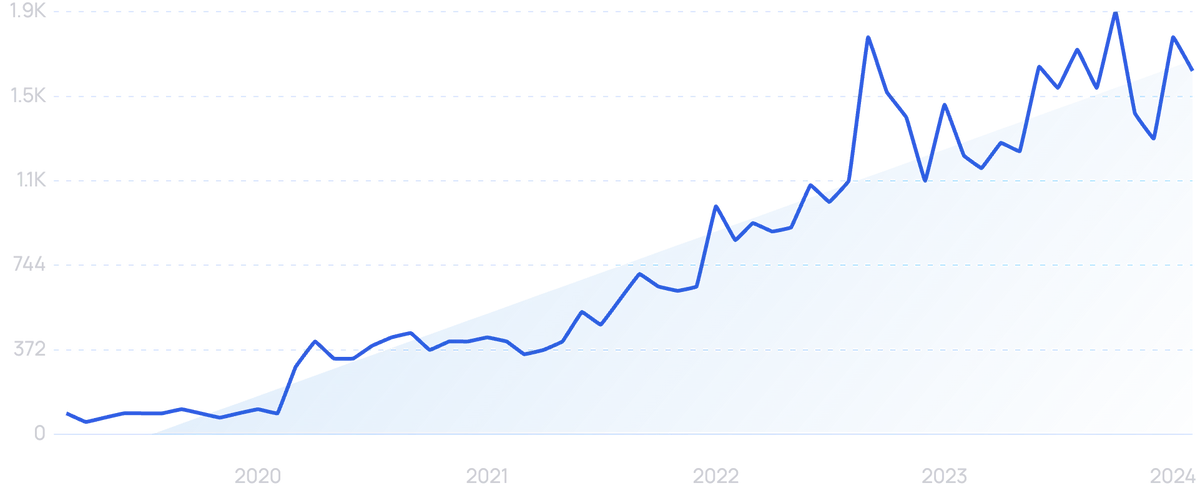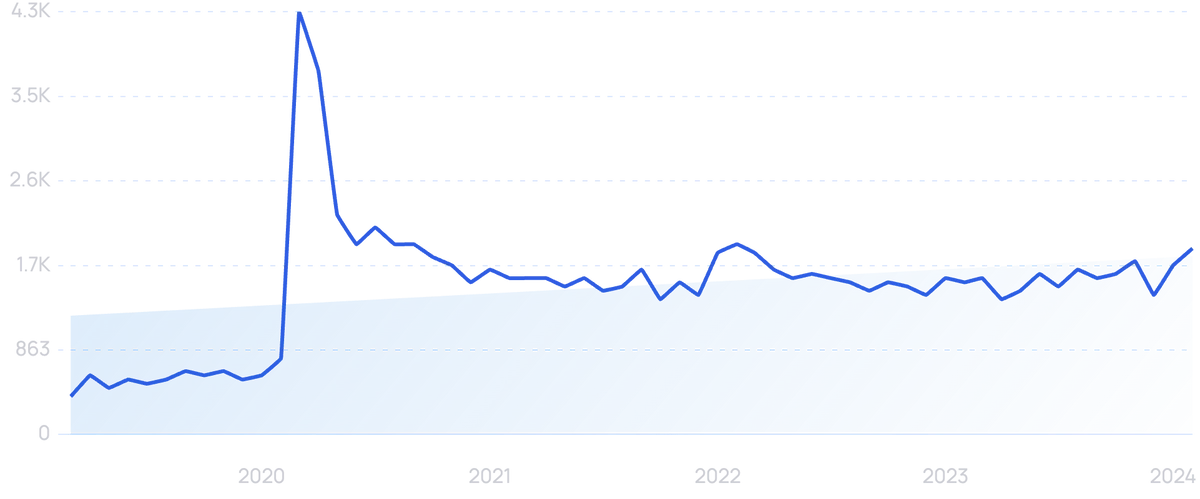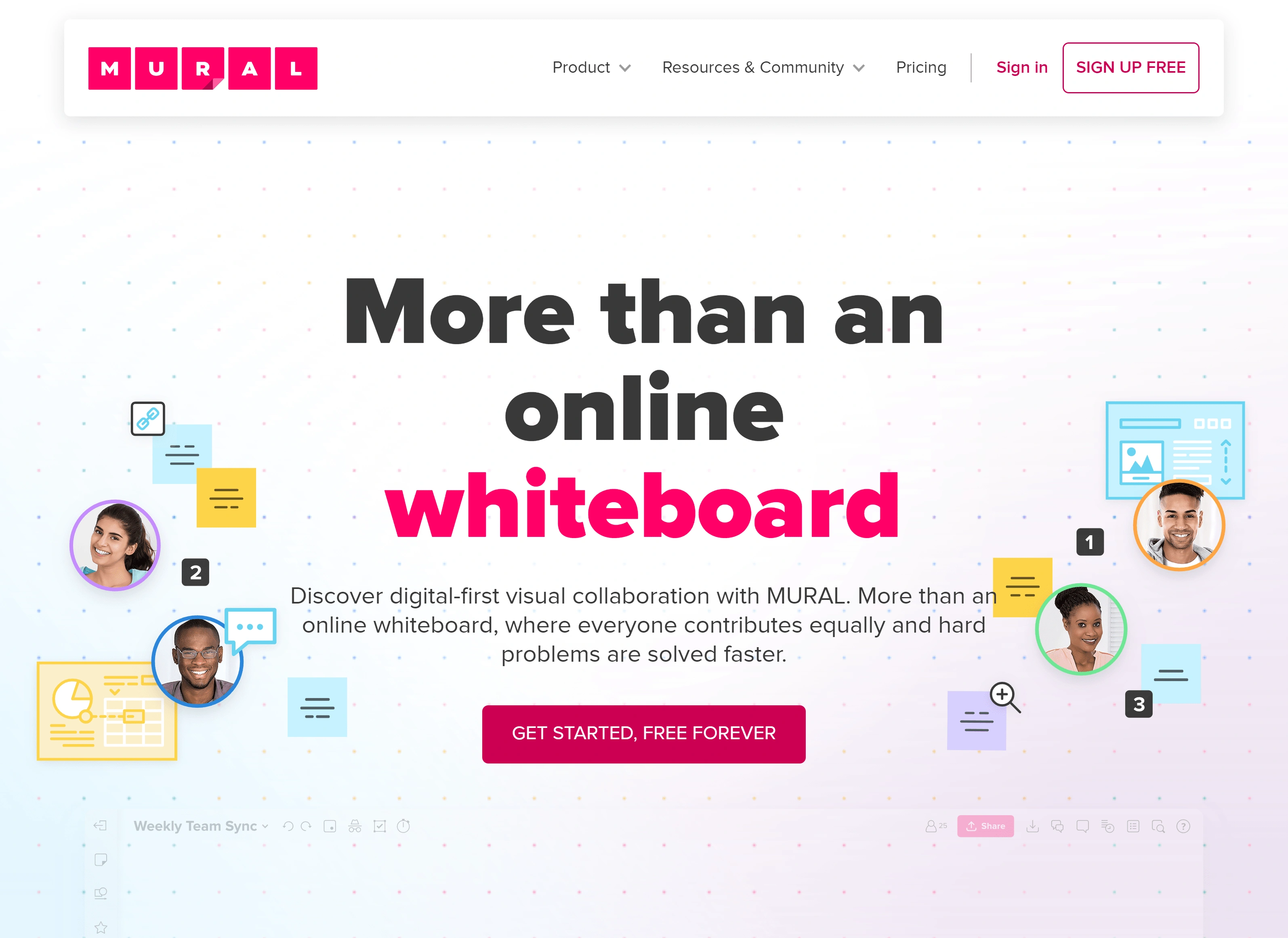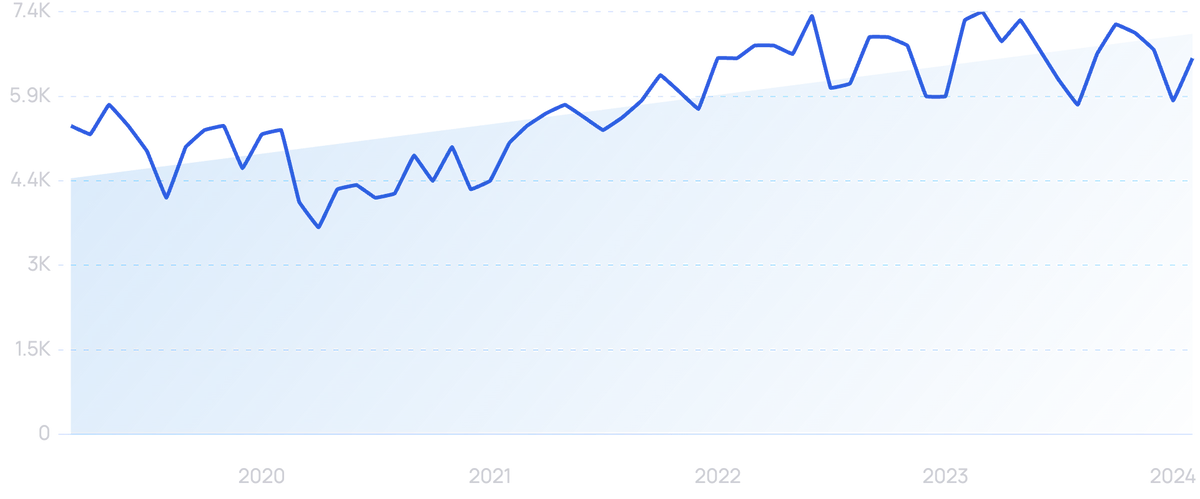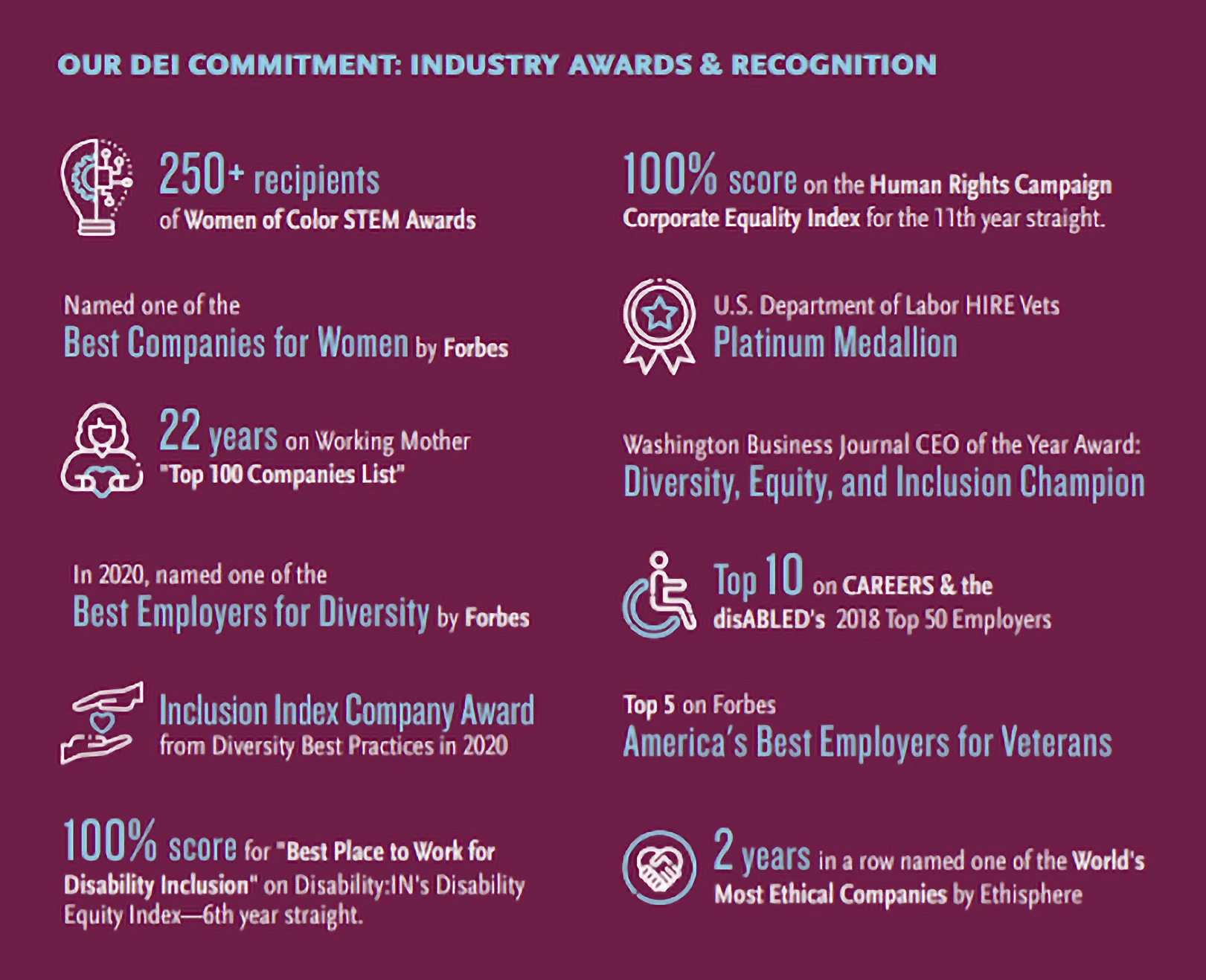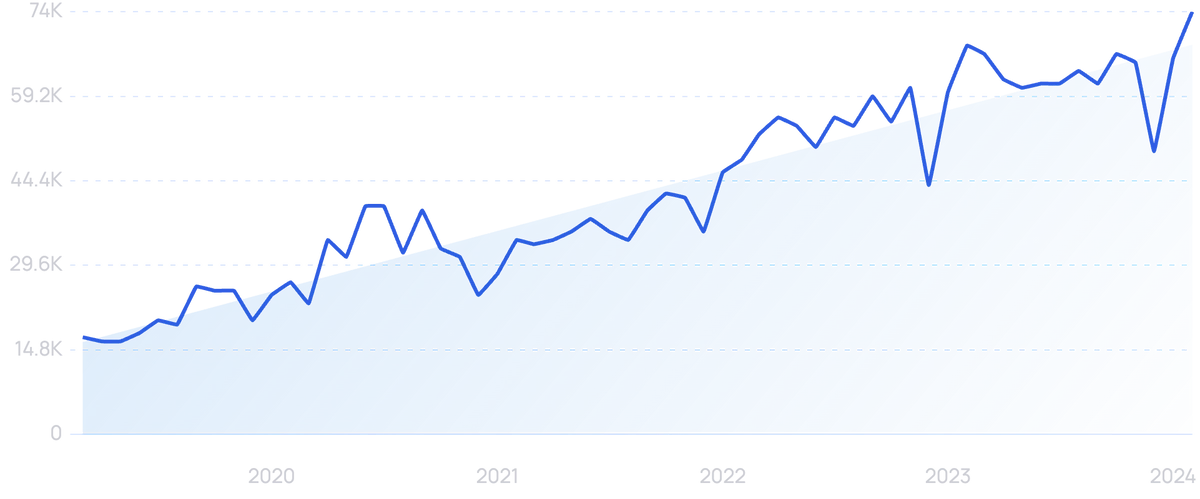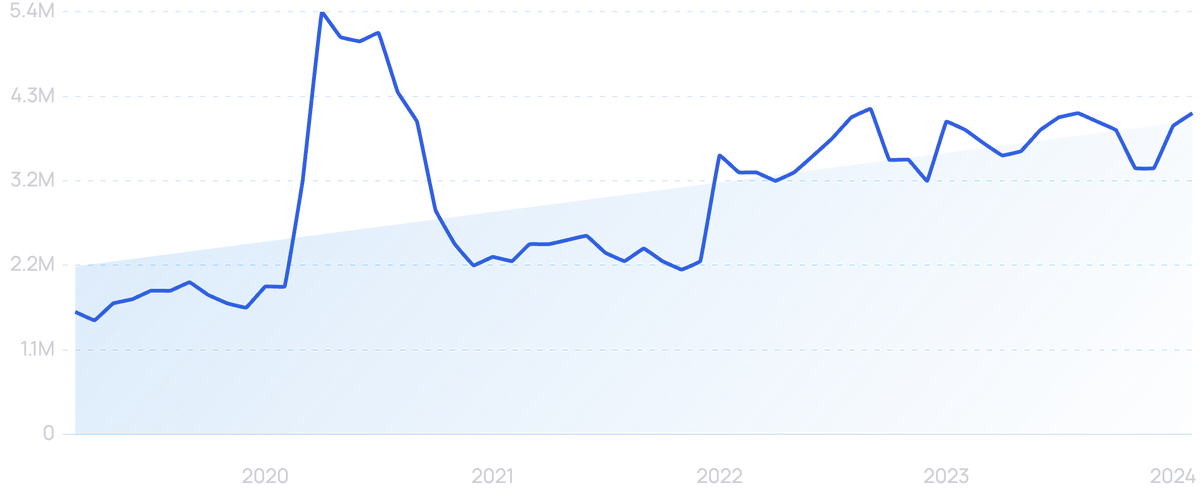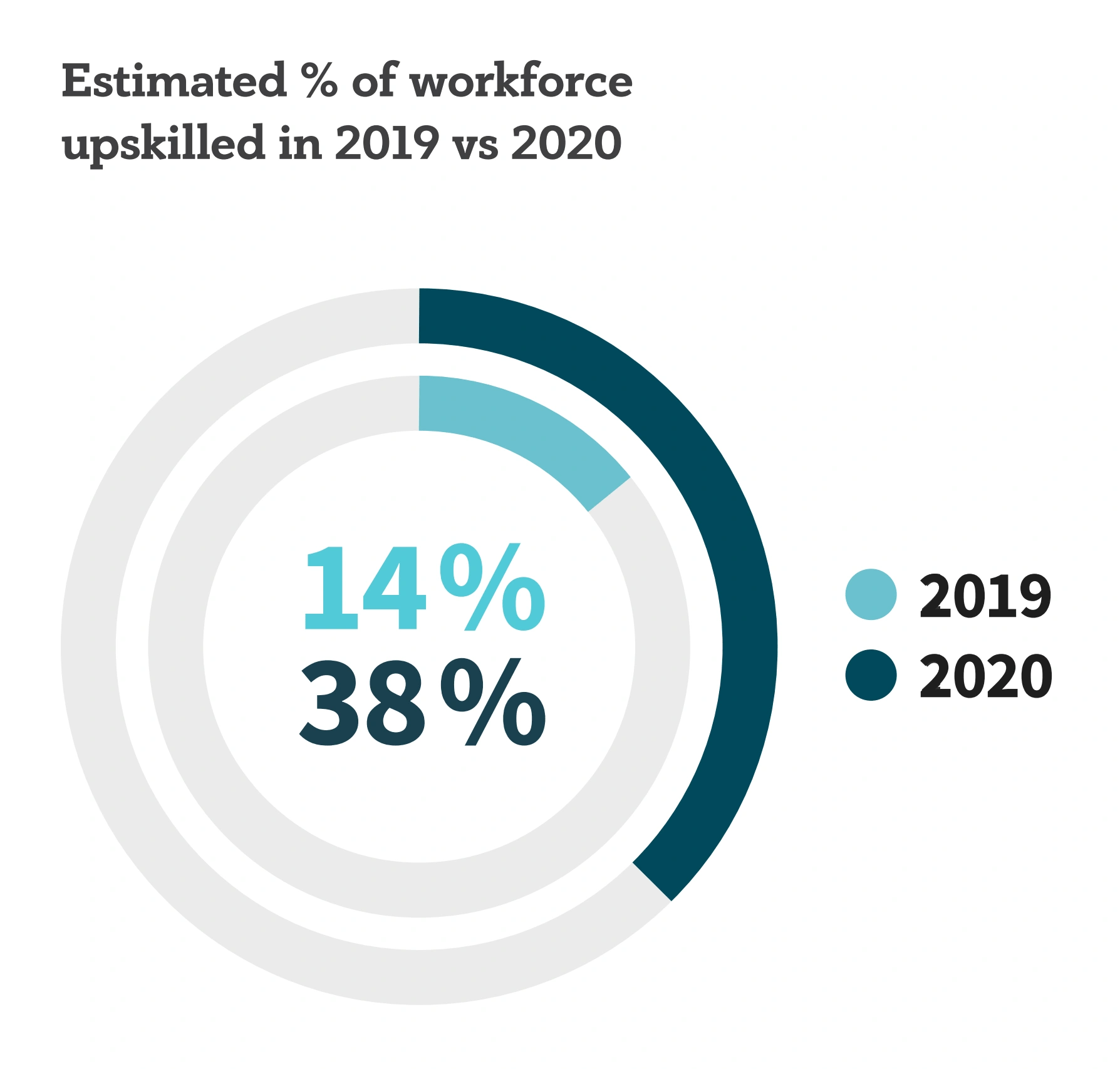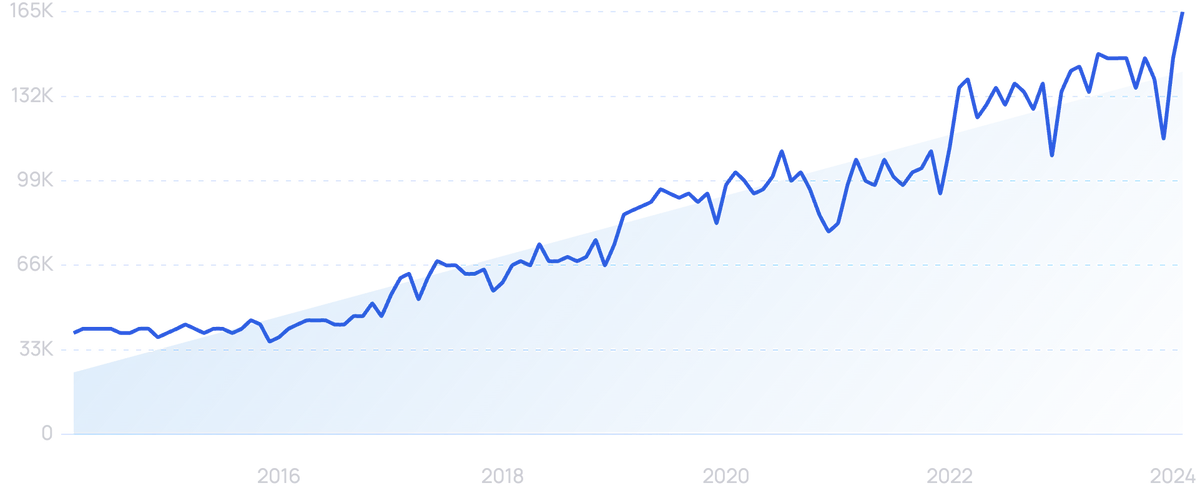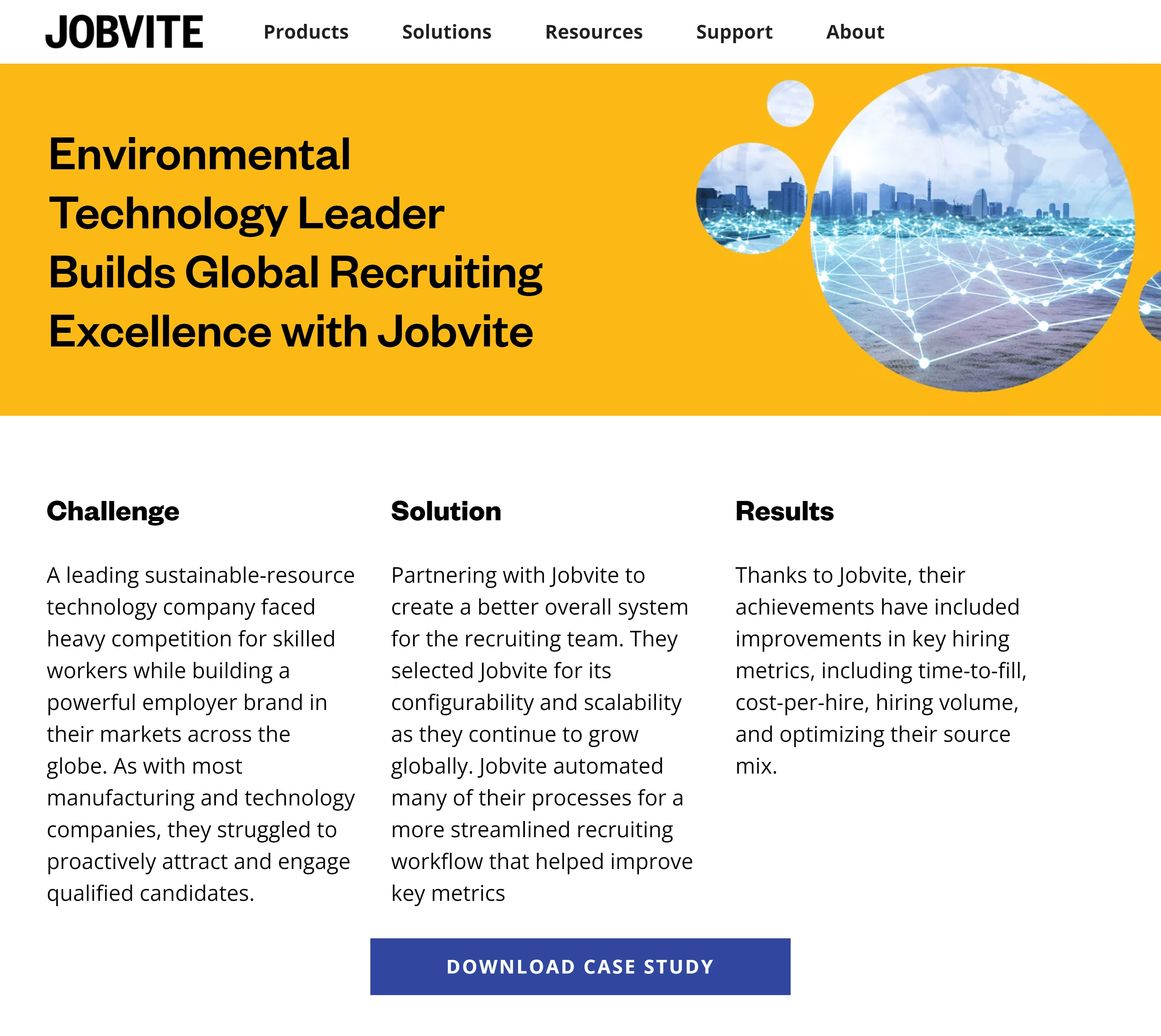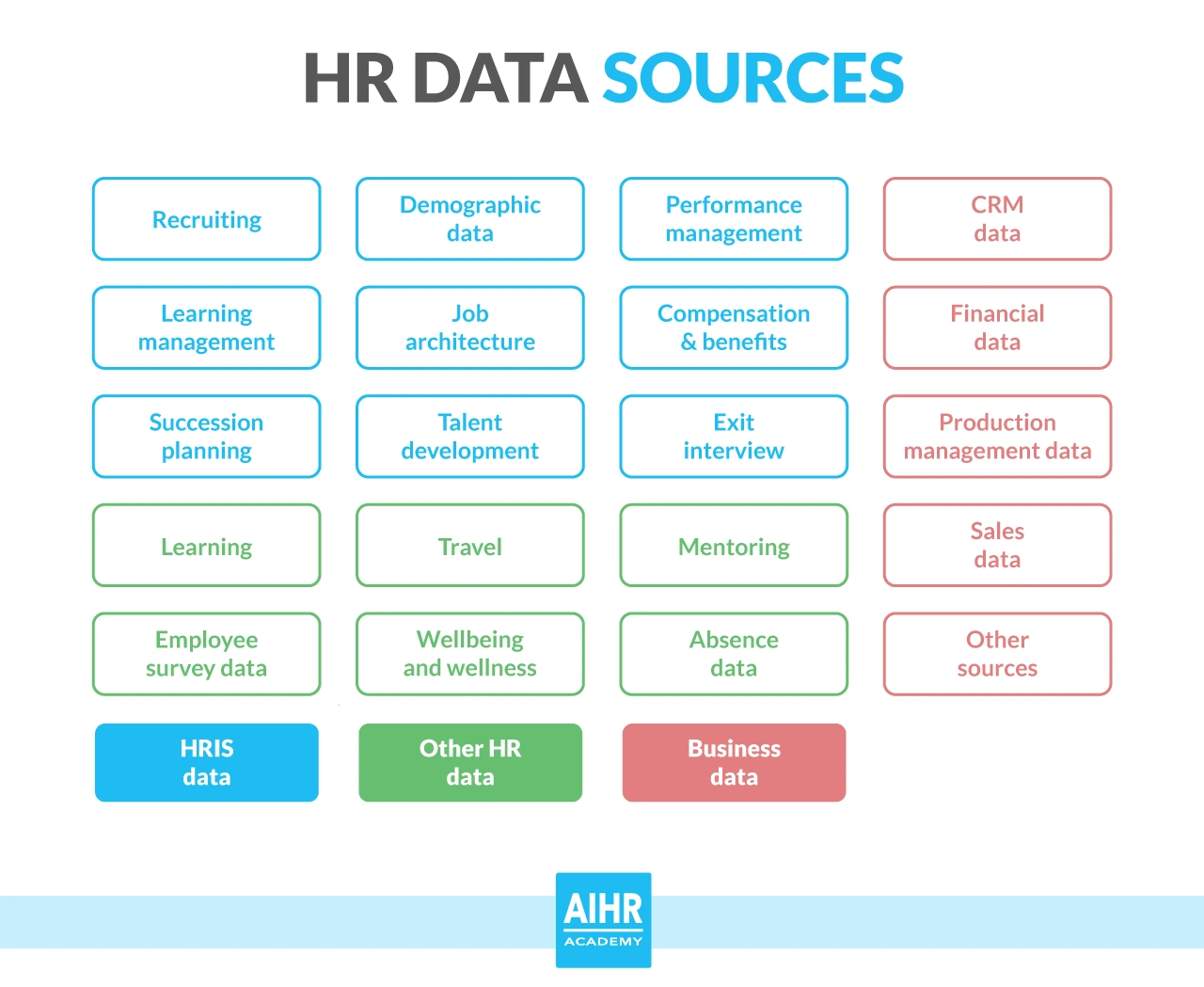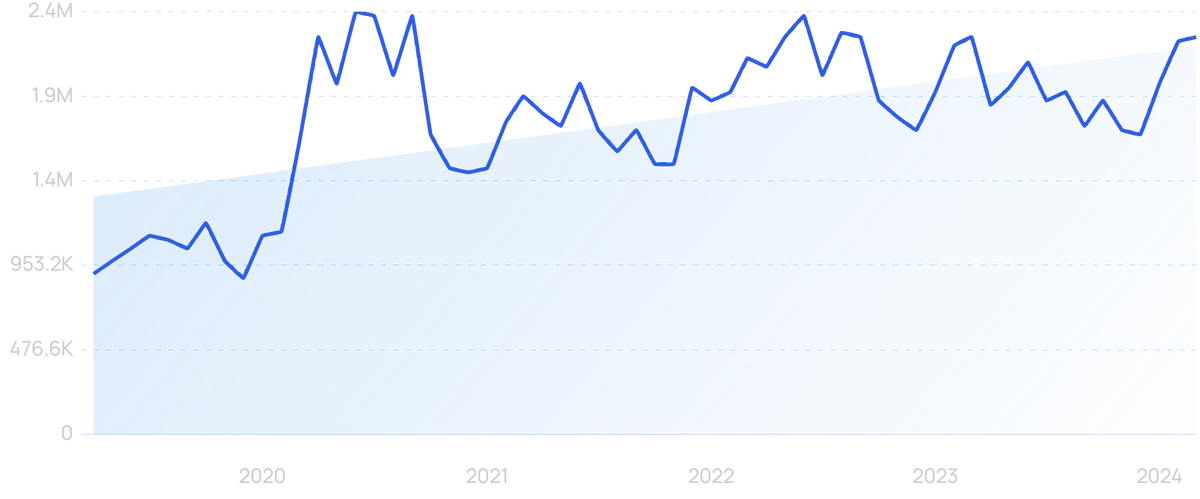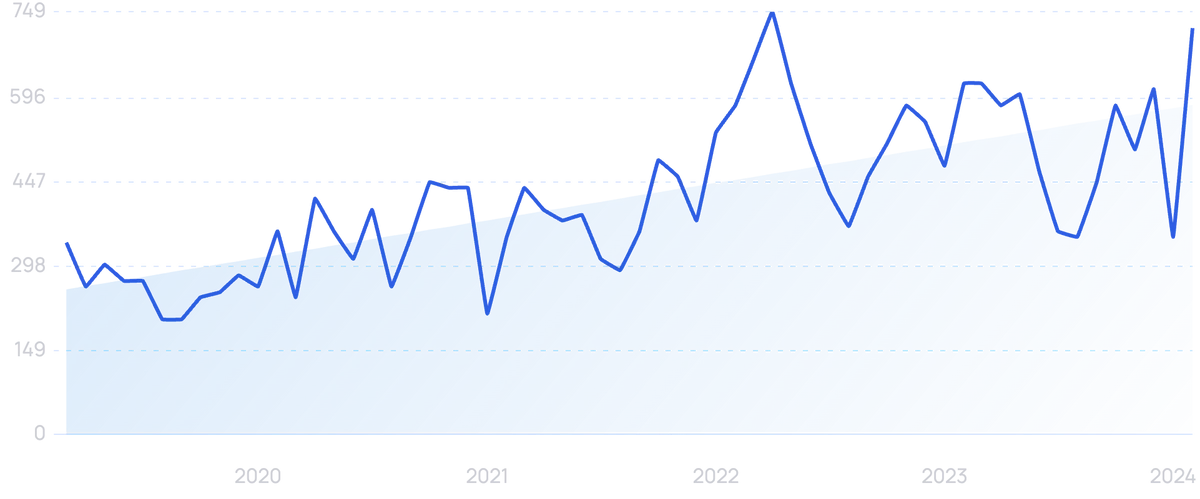
7 Top HR Trends in 2024
You may also like:
Organizations are re-strategizing, re-prioritizing, and adapting to a multitude of workforce changes in the wake of a global pandemic.
As the main employee resource support, human resources teams are bearing the brunt of workforce changes.
What can HR departments expect over the next 6-12 months? Here are the seven biggest trends in HR happening right now.
1. Improving support for remote work and hiring
During the pandemic, almost half of US organizations offered the option for remote work to employees.
This left many HR departments scrambling to figure out how to update their processes, structures, and communication methods to meet the needs of a remote workforce.
Even as some offices begin to open back up, 83% of organizations are anticipating keeping some level of remote or hybrid work .
Searches for “remote hiring” increased sharply in 2020, and remain high in 2024 (up 1,620% in 5 years).
For HR departments, serving the remote and hybrid workforce requires the recruitment process to go almost completely digital - causing an overhaul in the processing, scheduling, invitations, and interview processes.
Search growth for “remote teams” may have spiked. But over the long term have grown by 389% in the past 5 years.
Further, hiring for remote roles has led more organizations to embrace the gig economy to fill immediate needs.
Yet the rise in remote work also increases the need to be “always-on”, causing a spike in feelings of burnout, anxiety, and stress.
In a recent Gartner study, 75% of HR leaders agreed that an increase in the number of virtual touchpoints employees face puts them at risk for burnout.
This study also revealed that 40% of hybrid or remote employees experienced an increase in the length of their workday over the previous 12 months.
To combat burnout and extended hours, more remote work models are adopting asynchronous collaboration or the ability for employees to work outside of “normal” business hours.
The asynchronous collaboration focuses on the outputs achieved, rather than set hours worked. This allows employees to work whenever, and however works best for them.
Doing so can enable employees to be more productive and produce higher-quality work while experiencing fewer feelings of stress, anxiety, or burnout.
However, it’s important to remember that not all remote work-enabling tools are asynchronous.
While many organizations have updated their email, video, chat, and file-sharing tools to support remote work, a rise in digital whiteboard tools like Mural have gained traction as well.
Mural's homepage.
These tools mimic the in-person flow of brainstorming and planning sessions and allow employees to contribute to group work whether they’re in-person or remote.
2. Supporting employees’ physical, mental, and emotional well-being
The pandemic has opened employers’ eyes to the criticality of mental health in the workplace.
Interest in the status of employees’ mental health and overall well-being is skyrocketing: more than three-quarters of surveyed organizations said employee mental health is now a top priority.
More employers are tracking their employees’ levels of happiness, burnout, and anxiety now that they have a clearer understanding of how these facets affect their workforce.
Average daily searches for “occupational burnout” have increased over the past 5 years.
More than ever, HR departments are working to provide comprehensive well-being benefits for their employees.
In fact, mental/physical/emotional well-being benefits are projected to become as table stakes as a healthcare plan and 401k.
Employers are supporting employees by expanding mental health benefits to include more sick and PTO days, company-wide mental health days, fitness stipends, webinars/classes, financial counseling, exercise/nutrition assistance, mental health resources, and supporting other well-being initiatives.
One organization that does exceedingly well in providing a top-tier wellness program:
Zappos.
In addition to the usual increased time off and flexible hybrid work policies many organizations have implemented, they’ve upped the ante with programs such as “Destination Wellness” to gamify financial, mental, and physical health.
Zappo’s wellness benefits
Zappos also makes it a point to prioritize mental health as a culture by providing mental health training for managers, company-wide mental health days, and events focused specifically on improving mental health.
3. Increasing diversity, equity, and inclusion changes
More organizations are emphasizing hiring practices that provide for and nurture a more diverse workforce.
After a summer fueled by protests and calls for social change, diversity, equity, and inclusion-related job openings rose by 55% – a signal that employers internalized these issues and are motivated to make lasting change.
“People want to work for companies where they can be their authentic and whole selves”, says Donna Kimmel, Chief People Officer at Citrix. "HR can lead the charge through programs that drive diversity and inclusion, and support well-being in a holistic way”.
Average daily searches for “diversity and inclusion officer” over the past 10 years.
Organizations are taking a more honest look at themselves to understand and acknowledge inequities that may be present and determine how to make progress.
To do this, organizations are increasingly prioritizing hiring diverse talent, opening up diversity and inclusion executive roles, and putting together workshops to uncover and problem-solve diversity-related issues.
Take a page out of Booz Allen Hamilton’s book - the global management consulting organization has received numerous accolades for its commitment to DEI initiatives.
Booz Allen’s diversity accolades
To do this, Booz Allen went further than forming a comprehensive (DEI) task force.
Their claim to fame is their racial and social equity agenda that digs deeper than surface-level problem solving and outlines six key pillars of impactful change at their organization, and how they transparently assess progress.
However, we're also seeing a counter-trend: a growing number of companies actively not including DEI in their hiring processes.
While governments are passing so-called "anti-DEI laws".
So it will be interesting to see what role DEI plays in HR departments in the coming years.
4. Investing in learning & development
Thanks to the increase in remote work, employees now have more time to spare without a commute.
Many have been using the extra time taking learn new skills, getting professional certifications, or trying something new.
One trend that’s been on the rise is an increase in e-learning or remote learning - where employees take advantage of online courses or virtual classes to “upskill”.
Average searches for “upskilling” have grown by 335% over the past 5 years.
72% of organizations believe that e-learning efforts help them increase their competitive edge for employees.
HR teams bolster employees’ e-learning and remote working endeavors by providing learning benefits in the form of education stipends and tuition reimbursement, partnering with online learning platforms such as Coursera and LinkedIn learning, or offering discounts on classes.
Average daily searches for “Coursera” are 162% higher than pre-pandemic.
Learning and development benefits help organizations as well: employers who proactively provide upskilling or reskilling opportunities are better able to retain talent in an increasingly competitive workforce.
A study by the Research Institute of America found that e-learning can increase employee retention rates by up to 60%.
According to a recent study by Udemy, the percentage of employees who were upskilled more than doubled from 2019 to 2020.
Source: Udemy Workplace Trends Report, 2021.
Investing in talent they already have and bolstering their skillsets allows employees to keep pace with technological advancements and trends without having to switch companies or careers.
And when it comes to upskilling, 62% of employers utilize e-learning to close the skills gap.
Source: Udemy Workplace Trends Report, 2021.
5. Upgrading processes with AI and automation
More and more HR departments are replacing repetitive, manual tasks by implementing artificial intelligence (AI) and machine learning (ML) into their current processes.
We've studied the top AI human resources trends and tools for 2025-2026.
In 2020, 17% of organizations used some form of AI-based solution in their HR departments. This was expected to increase by 30% by 2022.
Automation and AI allow HR personnel to spend less time on time-consuming, tedious back-office tasks (such as tracking employee attendance and work performance).
Instead, HR folks can invest in innovative, strategic change to better serve employees - such as employee engagement programs, wellness initiatives, and DEI work.
AI is also making an appearance during the recruitment process.
Specifically, HR departments are starting to lean on AI-based algorithms to automate and streamline resume collection and screening, online tests, and initial onboarding communication.
For example, platforms such as XOR can be utilized to source, communicate with, score, and schedule inbound and outbound job candidates - providing overall ease to the recruitment process.
XOR homepage
While providing a massive time saver for HR departments, it doesn’t sacrifice the candidate experience – NPS scores for the platform hover around 90%.
6. Improving data management, data-backed decision-making, and data privacy protocols
With so many operations going remote, HR teams have more data at their disposal to understand employee productivity, well-being, and other metrics.
In fact, 70% of today’s executives say people analytics is a top priority for their organization.
HR teams are learning that analyzing and understanding data can aid them in providing better employee experiences for current employees, and improve the hiring process for prospective ones.
Searches for “business intelligence” are up 317% over the past 5 years.
More HR teams are relying on dashboards and visualizations as a way to further understand their employee metrics.
For example, the usage of platforms such as Jobvite can help HR teams understand, track, and analyze the performance of their HR processes to help inform future decisions.
In a user case study, Jobvite implementation allowed the organization to experience an increase in data-driven decision-making, a reduction in recruiting bias, and an increase in hiring for “hard to fill” roles.
Source: Jobvite.
But data privacy laws are also changing.
This is forcing HR teams to consider how best to keep employee information private in an increasingly digital world.
Source: AIHR
One step organizations have taken in their effort to be more data privacy-conscious is adopting digital signature and storage products, such as DocuSign.
Searches for DocuSign have increased by 147% over the last 5 years.
E-signature and digital storage products allow organizations to sign, send, and store sensitive documents remotely, without sacrificing security – coming especially in handy for remote hiring, onboarding, and employee management.
7. More agile and timely performance management
In an increasingly remote-first world, it’s less likely employees will sit down with their manager for their annual review.
Instead, HR teams are figuring out how to create virtual feedback systems.
The typical formal annual review and feedback systems are notorious for low employee morale.
According to a Gallup study, only 14% of employees said their performance reviews inspire them to improve.
Yet trends show that HR teams are flipping the typical model on its head.
More organizations are leaning into continuous performance management, including regular feedback cycles (sometimes as often as monthly), and achievement recognition.
Search growth for "continuous performance management" is spikey. But are up 111% in 5 years.
Harvard Business Review notes that a normal cadence of communicating and building employees’ strengths results in higher employee engagement: nearly 7 in 10 employees who say their managers focus on communicating and building their strengths are engaged.
This is in stark contrast to those who say their managers are not focused on this type of communication – only 1% of these employees rate themselves as engaged.
One organization that completely overhauled its performance management process into a more engaging, beneficial practice is Goldman Sachs.
The global investment firm was notorious for its singular and rigorous annual review process, which reduced employees to a numerical score and cut about 5% of employees each year.
They’ve revamped this system, instead including a more well-rounded “grading” system and more frequent performance check-ins with management.
Coupled with the e-learning benefits discussed earlier, learning and development have become more ingrained into employees’ day-to-day roles.
Ultimately this generally leads to increased employee efficiency and morale and thus, satisfaction.
In fact, 93% of employees say they would stay longer with a company that invests in their development.
Conclusion
So there you have it – the top HR trends to keep an eye on in 2024.
In a world where remote work is exceedingly the norm, organizations are tasked with keeping employees engaged, happy, and balanced.
The trends above highlight the effort HR teams have made to improve employees’ work and personal lives, as well as improve their own internal processes to ultimately better support employees.
Stop Guessing, Start Growing 🚀
Use real-time topic data to create content that resonates and brings results.
Exploding Topics is owned by Semrush. Our mission is to provide accurate data and expert insights on emerging trends. Unless otherwise noted, this page’s content was written by either an employee or a paid contractor of Semrush Inc.
Share
Newsletter Signup
By clicking “Subscribe” you agree to Semrush Privacy Policy and consent to Semrush using your contact data for newsletter purposes
Written By


Josh is the Co-Founder and CTO of Exploding Topics. Josh has led Exploding Topics product development from the first line of co... Read more

